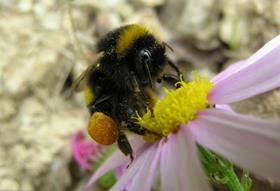
Farmers supplying The Co-op are laying a network of ‘bee roads' throughout the UK to support pollinators and promote bio-diversity.
Farms have so far planted 1,000 miles of hedgerows with the aim of boosting the environment and protecting local habitats.
First-year figures from the retailer’s environment-impact measurement tool, Enviro-Map, has uncovered the extent of agri-environmental schemes adopted by the farmers in their seven producer groups.
It shows that there are 1,000 miles of hedgerows that are managed across the farming groups; 1,400 hectares of woodland including native, coniferous and broadleaf areas; 455 hectares of watercourses and wetlands that provide habitats for species such as kingfisher and lapwing; 116 hectares of wildflower meadows; and 100 devices on farms to encourage wildlife into natural habitats including bird boxes, beehives and beetle banks.
Co-op Enviro-Map data also shows that renewable energy is a major focus for the 400 farmers who have taken part in the self-assessment programme, with 20 million kilowatt hours of energy being produced every year – enough to power 5,000 homes.
Caroline Morris of Manor Farm, which is part of the Co-op’s Beef Farming Group, has planted wildflower margins around the field boundaries on her Buckinghamshire farm. She said: “The wildflowers look fantastic in the summer and they’ve certainly increased the number of butterflies on the farm. Our neighbour, who produces honey, has found an increase in production since our wildflowers have been in place so there has clearly been an increase in the number of bees in the area.”
Matt Hood, Co-op’s trading director, said: “The need to create a more sustainable approach to farming and food production is just as important as producing high-quality, fairly-priced food and we can only achieve this with regular and reliable measurement of our producers. We are delighted to see that in year one alone, they are already offsetting their farming practises by contributing heavily to improved biodiversity levels which are so utterly critical to the air we breathe and the water we drink.”



